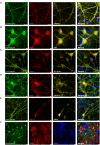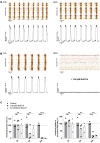Embryonic Stem Cell-Derived Neurons Grown on Multi-Electrode Arrays as a Novel In vitro Bioassay for the Detection of Clostridium botulinum Neurotoxins
- PMID: 28280466
- PMCID: PMC5322221
- DOI: 10.3389/fphar.2017.00073
Embryonic Stem Cell-Derived Neurons Grown on Multi-Electrode Arrays as a Novel In vitro Bioassay for the Detection of Clostridium botulinum Neurotoxins
Abstract
Clostridium botulinum neurotoxins (BoNTs) are the most poisonous naturally occurring protein toxins known to mankind and are the causative agents of the severe and potentially life-threatening disease botulism. They are also known for their application as cosmetics and as unique bio-pharmaceuticals to treat an increasing number of neurological and non-neurological disorders. Currently, the potency of biologically active BoNT for therapeutic use is mainly monitored by the murine LD50-assay, an ethically disputable test causing suffering and death of a considerable number of mice. The aim of this study was to establish an in vitro assay as an alternative to the widely used in vivo mouse bioassay. We report a novel BoNT detection assay using mouse embryonic stem cell-derived neurons (mESN) cultured on multi-electrode arrays (MEAs). After 21 days in culture, the mESN formed a neuronal network showing spontaneous bursting activity based on functional synapses and express the necessary target proteins for BoNTs. Treating cultures for 6 h with 16.6 pM of BoNT serotype A and incubation with 1.66 pM BoNT/A or 33 Units/ml of Botox® for 24 h lead to a significant reduction of both spontaneous network bursts and average spike rate. This data suggests that mESN cultured on MEAs pose a novel, biologically relevant model that can be used to detect and quantify functional BoNT effects, thus accelerating BoNT research while decreasing animal use.
Keywords: BoNT; MEA; botulinum neurotoxins; botulism; embryonic stem cell-derived neurons; in vitro bioassay; multi-electrode array; neuronal network.
Figures





Similar articles
-
Critical Analysis of Neuronal Cell and the Mouse Bioassay for Detection of Botulinum Neurotoxins.Toxins (Basel). 2019 Dec 7;11(12):713. doi: 10.3390/toxins11120713. Toxins (Basel). 2019. PMID: 31817843 Free PMC article. Review.
-
Progress in cell based assays for botulinum neurotoxin detection.Curr Top Microbiol Immunol. 2013;364:257-85. doi: 10.1007/978-3-642-33570-9_12. Curr Top Microbiol Immunol. 2013. PMID: 23239357 Free PMC article. Review.
-
Isolation and Characterization of the Novel Botulinum Neurotoxin A Subtype 6.mSphere. 2018 Oct 24;3(5):e00466-18. doi: 10.1128/mSphere.00466-18. mSphere. 2018. PMID: 30355669 Free PMC article.
-
Purification and Characterization of Botulinum Neurotoxin FA from a Genetically Modified Clostridium botulinum Strain.mSphere. 2016 Feb 24;1(1):e00100-15. doi: 10.1128/mSphere.00100-15. eCollection 2016 Jan-Feb. mSphere. 2016. PMID: 27303710 Free PMC article.
-
Assessment of ELISA as endpoint in neuronal cell-based assay for BoNT detection using hiPSC derived neurons.J Pharmacol Toxicol Methods. 2017 Nov;88(Pt 1):1-6. doi: 10.1016/j.vascn.2017.04.013. Epub 2017 Apr 29. J Pharmacol Toxicol Methods. 2017. PMID: 28465161 Free PMC article.
Cited by
-
Neuronal and Astrocytic Regulations in Schizophrenia: A Computational Modelling Study.Front Cell Neurosci. 2021 Aug 26;15:718459. doi: 10.3389/fncel.2021.718459. eCollection 2021. Front Cell Neurosci. 2021. PMID: 34512269 Free PMC article.
-
Hindbrain V2a Neurons Pattern Rhythmic Activity of Motor Neurons in a Reticulospinal Coculture.Front Neurosci. 2019 Oct 17;13:1077. doi: 10.3389/fnins.2019.01077. eCollection 2019. Front Neurosci. 2019. PMID: 31680817 Free PMC article.
-
Analysis of Motor Neurons Differentiated from Human Induced Pluripotent Stem Cells for the Use in Cell-Based Botulinum Neurotoxin Activity Assays.Toxins (Basel). 2020 Apr 25;12(5):276. doi: 10.3390/toxins12050276. Toxins (Basel). 2020. PMID: 32344847 Free PMC article.
-
Critical Analysis of Neuronal Cell and the Mouse Bioassay for Detection of Botulinum Neurotoxins.Toxins (Basel). 2019 Dec 7;11(12):713. doi: 10.3390/toxins11120713. Toxins (Basel). 2019. PMID: 31817843 Free PMC article. Review.
-
Defining parameters of specificity for bioluminescent optogenetic activation of neurons using in vitro multi electrode arrays (MEA).J Neurosci Res. 2020 Mar;98(3):437-447. doi: 10.1002/jnr.24313. Epub 2018 Aug 28. J Neurosci Res. 2020. PMID: 30152529 Free PMC article.
References
-
- Adler S., Bicker G., Bigalke H., Bishop C., Blumel J., Dressler D., et al. (2010). The current scientific and legal status of alternative methods to the LD50 test for botulinum neurotoxin potency testing. The report and recommendations of a ZEBET Expert Meeting. Altern. Lab. Anim. 38 315–330. - PubMed
-
- Arnon S. S., Schechter R., Inglesby T. V., Henderson D. A., Bartlett J. G., Ascher M. S., et al. (2001). Botulinum toxin as a biological weapon: medical and public health management. JAMA 285 1059–1070. - PubMed
LinkOut - more resources
Full Text Sources
Other Literature Sources
Research Materials

